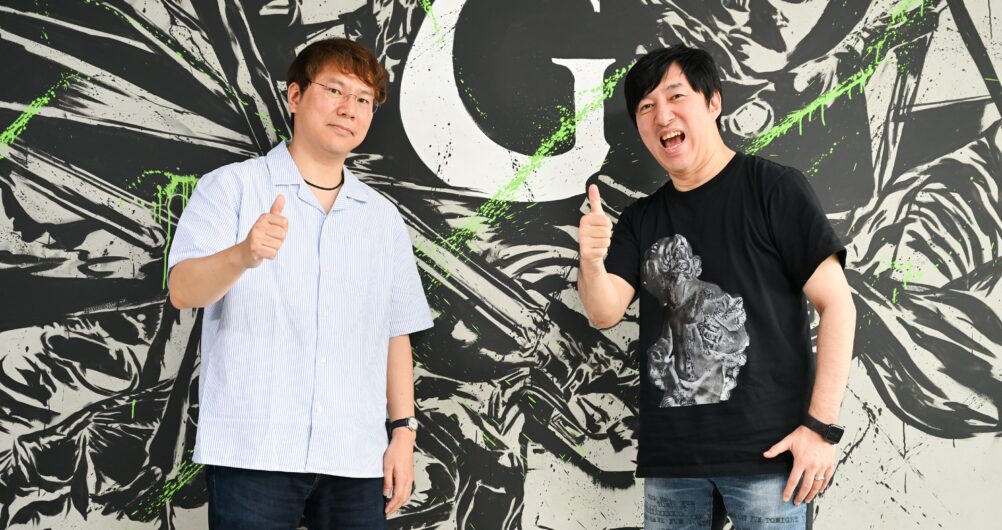Hiroyuki Kobayashi & Game Producers Interview Part 2
Kobayashi, who has been involved in numerous hit titles and currently serves as the President of GPTRACK50. This is the second installment of a series where Kobayashi discusses with leading producers in the industry. This time, his counterpart is Suda51, CEO of Grasshopper Manufacture. Both are part of the NetEase Games group and are currently developing new titles. They shared various stories with us.
Hiroyuki Kobayashi
President, GPTRACK50
At Capcom, has been involved in many popular series such as “Resident Evil” and “Sengoku BASARA.” In 2022, established the game studio “GPTRACK50” and is currently developing a completely new title.
Suda51
CEO, Grasshopper Manufacture
CEO and he has also worked on numerous projects as a director and scenario writer. His notable works include “killer7,” “No More Heroes,” “Lollipop Chainsaw,” and “Shadows of the Damned.”
Behind-the-scenes stories from the development of ‘killer7,’ which continue to influence their creative work today.
Kobayashi: This is the first time the two of us are having an official discussion like this, isn’t it?
Suda: That’s right. We worked together on ‘killer7’ about 20 years ago, but we handled interviews separately, so I believe this is the first time. When we first met, everyone around was speaking in Kansai (Western Japan) dialect, so I remember feeling a bit relieved and reassured when Kobayashi-san, who spoke in standard Japanese, joined us.
Kobayashi: For me, the contrast between Suda-san when he is in president mode and when he is in director mode was quite striking. When he is in president mode, he is very soft-spoken and considerate, but when he switches to creative mode, he becomes very much the director. He clearly states his opinions and absolutely won’t compromise on what he cares about. I was really impressed by his ability to switch like that.
Suda: I remember the time of ‘killer7’ very clearly. There were many troubles during development. Kobayashi-san joined us midway when the problems were piling up, and he resolved each issue swiftly. I was really grateful at that time. He meticulously mapped out the road to release and took care of everything until we reached the finish line.
Kobayashi: Nearly 20 years have passed since then, and it’s somewhat surreal that we’re now making games within the same group. By the way, I decided to join NetEase Games because Suda-san was already there.
Suda: Is that true?
Kobayashi: Because I believed that with Suda-san’s involvement, it would definitely be a good decision, I established GPTRACK50. So, this time, I’d like to talk about our work and the impressions we’ve had of working together. As I mentioned earlier, what left a strong impression on me was Suda-san as the president. At the time, I struggled with being considerate and dealing politely with customers, so I learned a lot from Suda-san about what it means to be a president.
Suda: It’s rare for me to be praised for my role as president.
Kobayashi: In terms of creativity, we only worked together on ‘killer7,’ but without that experience, I don’t think I would have been able to take such bold approaches with ‘Sengoku BASARA.’
Suda: ‘Sengoku BASARA’ was like a culmination of everything you wanted to do, wasn’t it, Kobayashi-san?
Kobayashi: Until then, I had a fixed idea of what games should be like, but working on ‘killer7’ with you made me realize that creative ideas, like incorporating animation or songs, could be much freer. This was a huge change for me. Being able to take various approaches in game development is thanks to ‘killer7’ and Suda-san. Participating in that game was a major turning point for me, so I’m really grateful… though the actual development process was really tough (laughs). I think I put a lot of pressure on you, Suda-san, to keep everything on schedule, which must have made things quite constraining for you…
Suda: No, no. I was grateful for that level of strictness because the situation required it to complete the development. As a president, I felt the need to meet deadlines, but as a director, I had a strong desire to perfect the game. During that time, Kobayashi-san’s strict guidance helped tighten things up. Because of that, we were able to successfully release the game. If it weren’t for Kobayashi-san, we might still be in development even now (laughs).
Kobayashi: No, I don’t think that would have happened (laughs).
What are particular focuses or priorities when creating characters and storylines?
── When you both interact with directors as producers, are there specific things you pay attention to or focus on?
Kobayashi: I always keep in mind that I want directors to do what they want to do. Steering those “wants” towards a direction that “sells” is the producer’s job. The sales target for each title differs, but if a director suggests something that might negatively impact sales, I work on correcting the course. Other than that, it really comes down to personal preference, so I think, “Let the director do it their way.” Suda-san, as a director, you’ve worked with various producers. Are there any particular approaches or things you are mindful of in those collaborations?
Suda: The compatibility and relationship between the producer and the director are really reflected in the game. By looking at the screen, you can generally tell what kind of interactions took place. That’s why it’s crucial to ensure a good relationship between the two to make a great game. I really appreciate producers who allow me to play freely but also provide firm guidance at the end. Kobayashi-san allowed me to work in exactly that way, so personally, I feel like we have great compatibility! (laughs)
Kobayashi: I’m honored to hear that! In this interview, I’d also like to ask about character and story creation. When starting a new project, Suda-san, do you consider the characters or the story first?
Suda: I usually start with the characters. For ‘No More Heroes’ and ‘Lollipop Chainsaw,’ I had a strong image of the protagonist first, and then built the story around them. On the other hand, with ‘Shadows of the Damned’ and the latest project we’re currently developing, the world-building came first. I wanted to create a certain world, and then designed a protagonist to fit into it. How about you, Kobayashi-san?
Kobayashi: In my case, we started by creating about eight project proposals, which we planned to refine through discussions. However, they were mostly completely reworked and transformed into something else. The final direction ended up being a concentration of what the director and game designers wanted. We essentially re-started from there. While I generally leave the game mechanics to the team’s judgment and creativity, I may occasionally provide input on the protagonist’s setting.
Suda: Why is that?
Kobayashi: The reason is that the direction for the protagonist is usually established first, followed by the creation of enemies and the development of the story. Because of this, I make sure to check the protagonist’s concept every time to ensure it remains consistent.
By the way, when creating characters, do you also consider the gameplay aspects or the genre of the title?
Suda: In my case, I usually start with an action-based approach. It’s something that’s become ingrained in me. I envision what would be interesting if that character appeared in the game and performed certain actions. With that as a premise, I create the character and then think about a system that highlights the character. Conversely, for adventure games, I often start with the world-building and setting. I solidify those first, and as I write the scenario, the characters emerge from that foundation.
The latest title is actively under development, and there might be an announcement in early 2025!?
── Would be great to hear more about the development of your new titles. How is the progress going with your new project, Suda-san?
Suda: With the goal in sight and the schedule and tasks already in place, it sounds like we’re set for a strong push toward the release. Full speed ahead!
Kobayashi: It sounds like you’re hinting at an announcement in the near future. Is there a timeline or any specific plans for sharing more details?
Suda: While I can’t make a definitive statement, we’re hoping to make some kind of announcement in the early part of 2025. Since this will be our first completely new title since joining NetEase Games, we want to offer users an experience that’s different from mere clone or copy games. We aim to provide a sense and experience that stands apart from existing games. We want players to think, “This game looks interesting,” and then discover something different from what they’ve seen before.
How about the titles from GPTRACK50?
Kobayashi: We are slightly behind schedule, but progress is being made steadily. However, we had mentioned during our first anniversary last year that we wanted to announce the title in our second year, but that seems a bit difficult at the moment. Nevertheless, the scenario is already completed, so we are now moving into the translation phase. Once the translation is finished, we will proceed with storyboarding and things will gradually get busier from there. This is the progress for the scenario, but regarding the game itself, the visuals are coming together nicely. The genre is an action RPG, and the action parts are already under development and are now entering the brush-up phase.
We are developing the game based on PC, but we have already completed testing its operation on actual consumer devices, which gives us some peace of mind.
Suda: Indeed, that’s crucial. It would be very problematic if issues arise at the final stage where the game doesn’t run on the actual hardware, so we also conduct early testing to avoid such problems.
── Both companies are advancing game development in a new environment. Are there any challenges or difficulties you’re facing?
Kobayashi: NetEase Games is still developing its consumer game sector, so there are still aspects that aren’t fully established. Although things have improved significantly, there can still be challenges depending on the requirements, and we’re continuously working to refine and improve the environment.
Suda: As Grasshopper, rather than as an individual, I’m particularly interested in what kind of opportunities NetEase Games can provide. Although they are set to establish and market our brand as a publisher, we have high hopes for leveraging the expertise of prominent figures like Kobayashi-san, Mr. Toshihiro Nagoshi, and Mr. Ryutaro Ichimura, who have previously worked on major titles. We strongly hope that with their support, we can successfully release our works to the world.
Kobayashi: Exactly, it’s all about creating achievements together from now on.
Suda: First, we need to strengthen the NetEase Games brand as a unified first-party effort. Of course, I’m sure preparations for that are already progressing steadily, but I’m very excited to see how it will all unfold.
Kobayashi: In companies with rigid role divisions, it often becomes a case of “that’s our job to handle.” However, at NetEase Games, there are no such strict rules, so I believe we can collaborate on various aspects. I’m really looking forward to the developments ahead!



